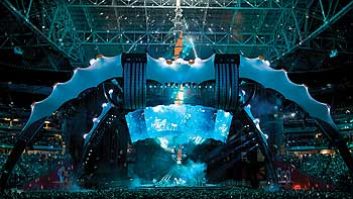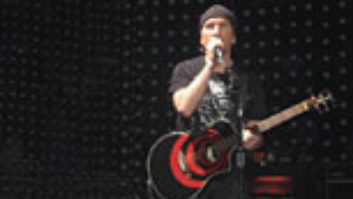It’s just two songs into U2’s two-plus-hour show at the HP Pavilion (San Jose, Calif.) in early April and audio director/front-of-house mixer Joe O’Herlihy’s right leg is bouncing along with the music. Standing behind one of two DiGiCo D5 consoles at FOH, O’Herlihy watches a band whom he’s worked with for 27 years rip through a 21-song set that included some of their best-known past tunes (“The Electric Co.,” “An Cat Dubh,” “New Year’s Day” and “Sunday Bloody Sunday”) and some of their new work — opener “Love and Peace or Else,” “Vertigo,” “Beautiful Day,” “Elevation” and “Miracle Drug.”
O’Herlihy’s exuberance could be caused by any number of factors, the least of which might be that he’s seeing a world tour kick off after 18 months of planning with U2 band manager Paul McGuinness. Those 18 months were spent investigating and auditioning everything from P.A. systems to mics to outboard gear. “You plan out the type of tour you’re going to do, the cities you’re going to be in, the type of territories, the worldwide aspect of it and whether it’s going to be an indoor arena tour or an outdoor stadium tour, and then you look at what’s required in the sense of cutting your cloth according to measure,” O’Herlihy reports.
Even while O’Herlihy spent time checking out other systems, the team returned to Clair Bros. Audio, carrying 44 i4 cabinets, 40 i4b subs, 12 Showco Prism Series 1 sub-lows, a number of P4 “Piston Box” rear- and center-fill cabinets and eight FF2 front-fill cabinets. “We have brand-new front-fills and we’ve changed the sub-low configuration slightly for space reasons, but the P.A. is basically the same one we used on the Elevation tour,” explains systems engineer Jo Ravitch. “We’ve gone to the P4 rear-fills because we have a little more freedom on where to put them and they cover more than most of the arrays we have available.” Powering the main cabinets are 15 Crest/QSC amp racks; seven Carver 2 amps are used for the rear- and front-fills, as well as the subs. The standard cadre of outboard gear — Lexicon 480L and PCM70, Yamaha SPX-1000, Eventide H3500 and TC Electronic 2290 — is also at FOH.
The overriding concern for any U2 tour, O’Herlihy says, is bringing a studio-like quality to the stage. “We do spend quite a bit of time in rehearsal,” he says. “The work ethic that this band introduces at every level — from the blank canvas that we have when we go into the studio to the finished product when you leave the audience singing ‘How long to sing this song?’ at the end of ‘40’ as the show closes out — requires a huge effort. It’s always been a huge responsibility to make sure that the onstage [sound] is as good and is delivered as well as the creative product that comes from the studio. From that point of view, we do agonize over things, and at this period at the start of a tour, it’s 48 hours a day, eight days a week. The total commitment to that value is why we’re getting such good results so far.”
MIKING THE BAND
While the goal is to get as much of the studio sound into the live setting, O’Herlihy reports that there have been times when mic selection has made the live sound just too perfect. For instance, when it comes to The Edge’s guitar setup, “We’ve always started out with what they used in the studio where it sounded great,” O’Herlihy says. “But when it comes to what we’re doing out here, sometimes those things just sound too good and he’s looking for that extra bit of distortion that he feels is part of the image of his sound. Sometimes, good microphones don’t deliver that, but when you put a crusty [Shure] 58 in front of it, you don’t have to do anything to it.”
Picking the right mic for the guitar amps turned out to be crucial, as the number of amps has doubled since the Elevation tour. “The Edge orchestra has finally decided to go from a string quartet to a symphony,” O’Herlihy says with a laugh. Three Fender amps have joined the three Vox AC30s — as well as the standby “Vox In a Box” that is now a part of The Edge’s live sound — which makes things interesting for the crew. “The amplifier technology is all vintage and we just trust in God that it works every day when we take it out of the box.”
O’Herlihy opted to change some things while miking the drum kit. “There was a time when the aesthetic nature of microphone technique became the feature, and everyone went for the smallest, grooviest, fashion-driven commodities,” he explains. “But after listening to what they were doing in the studio with big old Neumanns for the kick drum and ambient overheads, I went back to using the larger-diaphragm microphones.”
Larry Mullen’s kit is now miked with Sennheiser 421s on the toms, a combination of Shure Beta 52 and 91 on the kick drum, an 81 on the hi-hat, an Audio-Technica 4050 on the overheads and an AKG 460 on the ride cymbal positioned underneath by the bell. On snare, he’s using a Shure 57 (fitted with a Beta windscreen), with Beyer M88 on top and a Shure 56 on the bottom. “I’m sure the Beta windscreen does something from a sonic perspective, but I think it’s more of an insurance policy to stop Larry from knocking the head off of the 57, which he’s done on several occasions,” he says, laughing. “He’s quite the industrious drummer when he gets going.”
Bassist Adam Clayton is continuing to use the Ashdown speaker and amp technology that he started to use on the last tour, and O’Herlihy mikes the cabinet with a Sennheiser 421. He’s also getting an effected line from Clayton’s rig and a feed from a Line 6 Bass POD. Regarding the latter, “I call it ‘the energizer’ because it gives me a really clean quality of the actual bass sound without any sonic devalue,” O’Herlihy says. “I use that for depth of field for the bass and sometimes for intelligibility, because for some songs, like ‘City of Blinding Lights,’ the bass is the driving implement that pushes the sound along.”
As for Bono’s vocals, O’Herlihy says, “We’ve tried 101 different manufacturers because I’m always striving to figure out what’s out there,” he says. Yet he continues to come back to the Shure Beta 58: The crew has eight of them ready to put into action because of the singer’s constant onstage activity. “With him, anything goes, so we have to be prepared for it,” O’Herlihy says. At FOH, Bono’s vocals go into a Manley VoxBox and into the DiGiCo D5’s preamp. The singer also plays guitar on six or so tracks on the set list and O’Herlihy has an SM58 on a Vox AC30 to get those sounds.
Both Mullen and The Edge add background vocals to the U2 sound. Mullen uses a Countryman microphone on a headset, while The Edge sings into a Shure Beta 58 at the piano position and onstage. He also has a Countryman headset on hand.
THE BUNKER
Back in the old days, the under-stage space was a place to store road cases, extension cords and the random gum wrapper. Those days seem to be long gone, especially during this tour, where everything from changing rooms to monitor engineers are located under the stage. In fact, Robbie Adams, Dave Skaff and Niall Slevin spend the two-plus hours there working on the band’s in-ear monitor mixes. Adams handles the mix for Bono and The Edge, as well as records the show, while Skaff works up Mullen and Clayton. Slevin assists Adams with The Edge’s monitor mix.
“There’s a lot going on,” Adams says of the reason why the monitor responsibilities are split, “and it’s really too much for one person to do. It’s been tried, and it just doesn’t work.”
Adams is mixing on a DiGiCo D5 console, and for Bono’s vocals, he is using a Neve 1083 preamp and an LA-2A. “It’s not something that usually would come out on the road, but they wanted to start with what they had in the studio because they liked the sound there,” he explains. “If that doesn’t work, then at least we went to what we liked and then we pared it back from there.” Bono, Mullen and Clayton all wear Future Sonics Ear Monitors.
According to Slevin, The Edge is experimenting with a number of different in-ears manufacturers. “His mix is extraordinarily musical and that’s why there has to be so much concentration on it,” he says. “When he sings, he’s found that the seal around his ears comes loose, so we’re trying different sets of ears, some with foam and some without foam.” For the San Jose show, The Edge was on Etymotic ER4 earpieces.
Adams’ recording responsibility is made easier thanks to the D5’s MADI output, which goes directly into a Nuendo rig supplied by ADK Pro Audio. Every show is being recorded, and so far, the tracks have been used on VH1 and HBO. Plans are also in the works to offer live recordings or work with a service such as iTunes.
Skaff, who has been working with the band since 1985, is mixing on an ATI Paragon II, preferring the analog desk to a digital one. “I’ve spent time with pretty much all of the digital consoles and some of the new ones just coming out, but the demands of this job, the number of outputs that I’m using for three guys, is fairly over the top. I’m using every output of this 40-output console and I’m certainly using nearly every input,” he says.
AN EXERCISE IN REDUNDANCY
Bono’s collection of eight Shure 58s and three Manley VoxBoxes is just the beginning of the duplication found on this tour. From the pair of D5s that are at FOH to the extra D5 and Paragon II that will be available in the monitor bunker to the extra set of guitar effects, U2 is a study of redundancy. “It’s a double-edged sword,” says Ravitch, “because the redundancy has to work if it’s truly going to be redundant and that means you’ve got to check it all the time. It’s got to be up and running simultaneously all the time, and that makes your day that much longer and a little bit more complicated. But if you’re going to have a redundant system, you’ve got to be able to step over to it at a moment’s notice.”
Just how far does it go? Adams has doubled his Nuendo rig so each show is recorded twice in the monitor bunker and an assistant records the shows at FOH with a CD recorder.
AT THE END OF THE DAY
To be sure, the entire crew takes great care to make sure every fan walks out of the venue smiling while singing the exiting salvo from “40.” “That’s part of my job,” O’Herlihy concludes, “and it’s certainly my responsibility to make sure that is the case, because with a band like U2, every element of everything we do is scrutinized to the ‘nth’ degree to make sure it’s perfect. We spend a hell of a lot of time to make sure we get it right, because the fans are the people that will ultimately pay our wages. The band puts a huge effort into it to make sure we’re all doing the right thing. I won’t say that enough people get it wrong, but we try our hardest to get it right. We may not get it right every single time, but at least we died trying.”
David John Farinella is a San Francisco-based writer.


